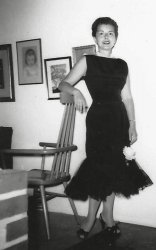
MAY CONTAIN NUTS

Search Shorpy
SHORPY ART

Framed or unframed, desk size to sofa size, printed by us in Arizona and Alabama since 2007. Explore now.
Join and Share
Ad-Free Shorpy
Shorpy is funded by you. Patreon contributors get an ad-free experience.
Learn more.

Recent comments
- Alas, hidden from view
- Exclusive pump
- Details, Details
- What's that building to the left of the tower?
- Coal Barges
- Bromo-Seltzer
- Inner harbor
- The Basin
- What a headache!
- Giant stepladder?
- Baldwin 62303
- Baldwin VO-1000
- Cold
- No expense spared
- Tough Guys
- Lost in Toyland
- And without gloves
- If I were a blindfolded time traveler
- Smoke Consumer Also Cooks
- Oh that stove!
- Possibly still there?
- What?!?
- $100 Reward
- Freeze Frame
- Texas Flyer wanted
- Just a Year Too Soon
- WWII -- Replacing men with women at the railroad crossing.
- Yes, Icing
- You kids drive me nuts!
- NOT An Easy Job
Member Photos
The Shorpy
Print Emporium
Print Emporium
Search Shorpy
Search results -- 30 results per page
- Earl Smith: 192x
- ... facade as shown here.
Retrosheet shows the Giants at Cincinnati on 5/13/20, and Crosley Field (called Redland Field in 1912-1933) ... Posted by Dave - 09/09/2011 - 11:36am -
![Earl Smith: 192x Earl Smith, New York National League (Giants). Date written on this glass-plate negative is June 9, 1923. Although another from this 5181 series of pictures taken at the Polo Grounds has "5/13/20" scratched into the emulsion. View full size. 5x7 glass negative, George Grantham Bain Collection.
1920? 1923?According to Retrosheet, on June 9, 1923 the Giants played at Pittsburgh. Images of Forbes Field do not match the upper deck facade as shown here.
Retrosheet shows the Giants at Cincinnati on 5/13/20, and Crosley Field (called Redland Field in 1912-1933) appears similar (see http://www.viewimages.com/Search.aspx?mid=71652668 for an example from 1938), but not identical.
However, the Polo Grounds does match (http://www.dugout-memories.com/goffpol7.html).
So it appears the game was in New York, but on neither date given. I'm stumped without knowing who the opponent is.
[It's definitely the Polo Grounds. Another shot from this series shows Pete Kilduff of Brooklyn there on what would seem to be the same sparsely attended day. - Dave]
So it's 1920According to Baseball-Reference.com Pete Kilduff retired after the 1921 season, playing for the Brooklyn Dodgers/Robins in 20 and 21. Let's check 1920.
Retrosheet shows the Giants hosting Brooklyn on May 5-7 1920, just days before the May 13 date given. May would also fit with the low attendence, since school would still be in session.
Oh, the Giants took 2 of 3 against Brookyn that week but finished 7 games behind the Robins, with Brooklyn losing the World Series 5-2 to Tris Speaker's Cleveland Indians.
Thanks for the lead on Kilduff, Dave.
Could this...possibly be a photo of pre-game batting practice? The catcher appears to be wearing the same style/color uniform as Earl, the "crowd" is a bit sparse and that filthy home plate would bring shame to any whiskbroom-toting umpire.
(Note: in 1923, Smith only appeared in 24 games for the Giants, spending the remainder of the year [72 game appearances] with the Boston Braves although I've not been able to find the date he was traded).
Denny Gill
Chugiak, Alaska
Earl SmithSmith was traded to Boston along with Jesse Barnes on June 7, 1923. The Giants received, in return, Hank Gowdy and Mule Watson. (Baseball Encyclopedia)
Baseball UniformsAccording to the "Dressed to the Nines" baseball uniform database, the uniforms of both players match New York (batter) and Brooklyn (catcher) for 1920 and 1921. New York's home and Brooklyn's road uni's are virtually identical those years, including the socks. Brooklyn had a B on the right sleeve. It would be hard to detect the gray of the catcher's uniform. Even their caps were the same, except for logos.
(The Gallery, G.G. Bain, NYC, Sports)](https://www.shorpy.com/files/images/30394u_0.thumbnail.jpg)
- Through to Morgantown: 1905
- ... in 1908. The boat facing us is the Queen City, built at Cincinnati in 1897. A very posh boat with top finishes and fittings, it catered ... Posted by Dave - 05/15/2017 - 3:33pm -
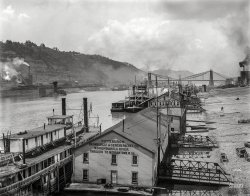
- Louisville Wharfboat: 1905
- ... "Big Four" bridge which was built to carry the Cleveland, Cincinnati, Chicago and St. Louis railroad (Big Four) across the Ohio River. If ... Posted by Dave - 07/07/2014 - 12:47pm -
![Louisville Wharfboat: 1905 Circa 1905. "Ohio River levee at Louisville, Kentucky." Note the "U.S. Life Saving Station." 8x10 inch glass negative, Detroit Publishing Company. View full size.
Connected finallyThe Big 4 bridge in the background is now a pedestrian bridge connecting the 2 sides (finally). It's a great addition to downtown.
Busy!There sure is a lot going on in this photo!
Still afloat!The Life Saving Station(#10) is still there and is now used as the wharfboat for the historic sternwheeler Belle of Louisville.
[The present Life Saving Station #10 dates from 1929. -tterrace]
Ol' Reliable That Old Reliable Laundry cart in the middle looked pretty new - so I looked and found a Google Book's result that said it was Organized Aug, 4, 1904, for $3,000 and paid $3 in tax. So, the cart (or the paint job on the cart) was probably a year old or so old when the picture was taken.
Railroad BridgeThe bridge in the background appears to be the "Big Four" bridge which was built to carry the Cleveland, Cincinnati, Chicago and St. Louis railroad (Big Four) across the Ohio River. If it is the Big Four bridge it is the first one; the bridge became inadequate for the traffic and was replaced in the late twenties. The Big Four eventually was merged into the New York Central and railroad traffic on the bridge was ceased. In recent years the bridge has been restored to allow pedestrian and bicycle traffic to cross the river.
(The Gallery, Boats & Bridges, DPC, Louisville)](https://www.shorpy.com/files/images/SHORPY-4a22248a.thumbnail.jpg)
- Washington Terrace: 1935
- ... to put in Interstate 71 coming out of the downtown Cincinnati area.
View Larger Map
Washington Terrace Neighborhood I looked at the Insurance Maps of Cincinnati, Ohio, Vol. 4, commonly known as a Sanborn Map, but the ... Posted by Dave - 07/12/2013 - 11:05am -
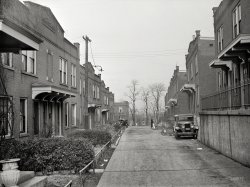
- Wilson Dam: 1942
- June 1942. Excursion steamer Gordon C. Green of Cincinnati approaching the TVA's Wilson Dam in Alabama. View full size. ... Posted by Dave - 08/03/2012 - 11:35am -
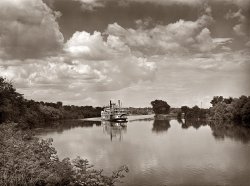
- General Store: 1943
- ... 1943. "Gas station on the bus route between Columbus and Cincinnati." Photo by Esther Bubley for the Office of War Information. View ... 3C Highway," named for the cities Cleveland, Columbus and Cincinnati, resembling this building. But the rail tracks to the right in the ... Posted by Dave - 06/09/2018 - 10:37am -
![General Store: 1943 Two pumps, no waiting.
September 1943. "Gas station on the bus route between Columbus and Cincinnati." Photo by Esther Bubley for the Office of War Information. View full size.
Hamilton, OhioIn 1940 there were two Eugene Disses living next door to each other in Hamilton, Ohio.
This could be Eugene Diss Sr., who in 1943 was a 67-year-old German immigrant with no occupation listed, or his son, who in 1940 was listed as a bartender.
In 1944 one of the Eugenes is listed as selling his "Blue Danube" restaurant in Foster's Crossing, Ohio.
Eugene Sr. died in July 1950, with his residence a;so listed as Foster's Crossing.
The Blue Danube still exists, and until 10 years ago or so - in the best Shorpy's tradition - was knows for its television watching, cigarette smoking monkey kept in a cage out front.
In earlier years it was called the Train Stop Inn, and now is the Monkey Inn.
Going by the census records, I'd venture the general store was very close by somewhere.
https://www.newspapers.com/clip/20856666/
[So these are the same Eugenes mentioned in the previous comments below. Excellent detective work on the restaurant! - Dave]
The Ohio DissesAccording to the 1940 Census, Eugene Diss was born about 1876 in Germany. Home in 1940: Warren, County, Ohio. Daughter: Minnie Diss.
A Little Bit of DissThe 1930 Census shows two Eugene Disses, father and son, in unincorporated Fosters, Warren County, as proprietor (Senior) and salesman (Junior) at a family owned store. There appears to be nothing left in Fosters, along the Little Miami River and the formerly very busy "Old 3C Highway," named for the cities Cleveland, Columbus and Cincinnati, resembling this building. But the rail tracks to the right in the old photo might place it at the intersection of that 3-C road and the former rail line, now a bike path, in Fosters. Maybe some other local history deep divers will find more.
(The Gallery, Esther Bubley, Gas Stations, Stores & Markets)](https://www.shorpy.com/files/images/SHORPY-8d33069a1.thumbnail.jpg)
- Withers Elementary: 1972
- ... today, grade 6A. Sadly, only one year here, then off to Cincinnati where we remained thru the end of grade school/middle school/high ... Posted by brinke - 08/21/2015 - 12:35pm -
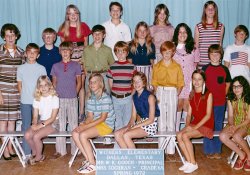
- Spaghetti Girls: 1921
- ... of Foulds Macaroni Company moved to Libertyville from Cincinnati in 1906. The structure, originally a ladder factory, was built in ... Posted by Dave - 09/03/2012 - 11:54am -
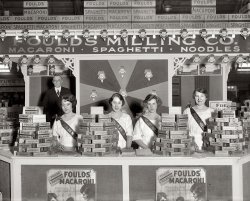
- Mal Temps: 1920
- ... not so revered by residents of his former hometown of Cincinnati) for the evergreen quote:
“Times are not good here (in New ... Posted by Dave - 10/02/2013 - 10:37am -
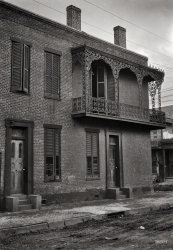
- River Coal: 1910
- ... held the record time for round-trip between Pittsburgh and Cincinnati (4 days, 20 hours, 15 minutes), for which she earned the nickname, ... Posted by Dave - 01/31/2014 - 9:35am -
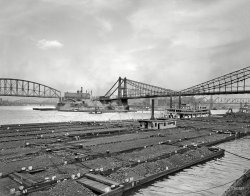
- Peerless Dental Parlors: 1905
- Detroit, Michigan, circa 1905. "Cincinnati, Hamilton and Dayton Railroad office, Woodward & Jefferson ... Posted by Dave - 08/08/2014 - 3:37pm -
![Peerless Dental Parlors: 1905 Detroit, Michigan, circa 1905. "Cincinnati, Hamilton and Dayton Railroad office, Woodward & Jefferson Aves." Last seen here, without the barefoot newsie. 8x10 inch dry plate glass negative, Detroit Publishing Company. View full size.
What do you supposeis the blurry, rectangular thing just above the manhole cover, behind the gent waiting for the streetcar? Is it rising, or falling?
[Abrasion on the negative. -tterrace]
How does that work?The Peerless Dentist upstairs advertises "teeth without plates" which was impossible in 1905 since dental implants hadn't been invented yet. Also, does anybody know what "vitalized air" was?
[Below from the Ohio State Journal of Dental Science, 1883. -tterrace]
Thank you tterrace for the enlightenment.
For Cash read CassiusCassius M. Havens was born in Allegany, New York in March 1845; in 1869 he married Adelaide Illick. They had 4 children: Beluach, Ninabelle, Grace and Hubert. Cassius was a sergeant in the Civil War in the 19th Regiment NY Volunteer Cavalry (later the 1st Reg NY Dragoons). Cassius died in 1907. I can't find a death date for Adelaide.
(The Gallery, Detroit Photos, DPC)](https://www.shorpy.com/files/images/SHORPY-4a20389a.thumbnail.jpg)
- Dinner to Go: 1921
- ... 35-Pound Bird Decorated
With Bunting and Flags.
Cincinnati, Ohio, Nov. 17. -- President Harding's Thanksgiving day turkey, a ... Posted by Dave - 09/11/2011 - 9:28pm -
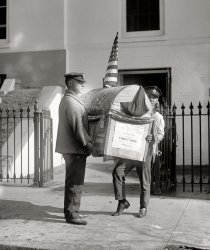
- Chesapeake & Ohio 300 and 1612
- ... class L-2 Hudson (4-6-4), just in off a passenger run from Cincinnati or Detroit; and #1612, a 2-6-6-6 Allegheny class H-8, used primarily ... Posted by Lost World - 09/23/2011 - 12:18am -
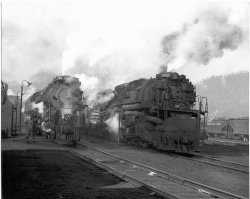
- 8th Grade Class, 1920's
- ... large box of photographs that I purchased from a dealer in Cincinnati. On the back it is marked "8th Grade Class Avondale School." Avondale is a neighborhood just north of downtown Cincinnati. The neighborhood was largely Jewish until the late 60's/early 70's ... Posted by Miss Golightly - 08/03/2012 - 9:07pm -
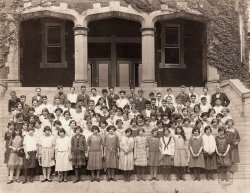
- All Aboard: 1919
- ... of Washington had to use 2 wires and poles, just like in Cincinnati, Ohio, Annapolis, Maryland, Havana Cuba; and parts of Greenwich, ... Posted by Dave - 09/17/2014 - 10:25am -
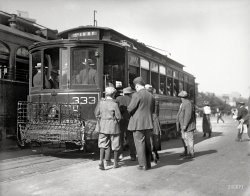
- Loaded for Bear but Hunting Hay ca:1950
- ... cousins at our farm in St. Martin, Ohio (just outside Cincinnati). This was the big summer getaway place for the family after my ... Posted by eggsoup - 09/20/2011 - 12:31am -
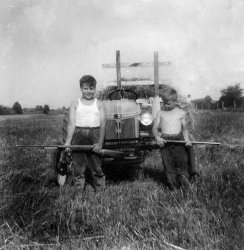
- Greendale Girls: 1939
- ... Maryland (near Washington, DC), Greenhills, Ohio (north of Cincinnati), and this one, in Wisconsin.
Greenbelt is a wonderful town, and ... Posted by Dave - 10/14/2019 - 10:11am -
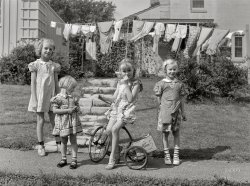
- Splicers
- ... size.
Somewhere in Ohio Helmet Rye was made in Cincinnati and Probst Furniture was in Pomeroy.
(ShorpyBlog, Member ... Posted by robertinaz - 12/03/2010 - 10:46am -
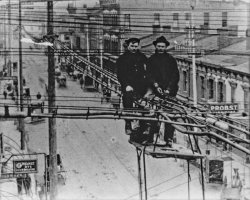
- Catching a Whopper: 1917
- ... with a cane pole in 1917 on the Little Miami River near Cincinnati, Ohio. She was 17 years old at the time and lived until 1969. The ... Posted by Jim McAllister - 05/10/2010 - 1:20am -
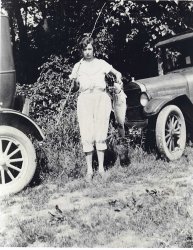
- C&O 310
- ... C&O 310, class L2a 4-6-4 Hudson type on ready track at Cincinnati Union Terminal service area, September 1950. Built by Baldwin in ... on C&O's flatter western main lines, working between Cincinnati/Detroit and Hinton, WV. E-8 diesels bumped the Hudsons from ... Posted by Lost World - 07/29/2016 - 8:35pm -
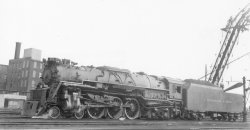
- Service Station Display: 1949
- ... board at my grandfather's service station in Delhi (Cincinnati, OH), 1949. View full size.
Illustrating the low price of ... Posted by jmanelis01 - 11/12/2010 - 1:41pm -
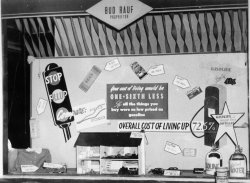
- AKA Convention: 1931
- ... 1920s. This is their 1931 convention at the University of Cincinnati. She's in there somewhere. View full size.
So much fur! ... Posted by sjack - 01/26/2018 - 7:28pm -
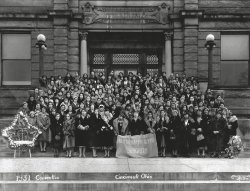
- War God: c. 1922
- My grandfather at the opening of Cincinnati's Blue Ash airport in 1922. While he had little to do with ... Posted by eggsoup - 09/20/2011 - 1:15am -
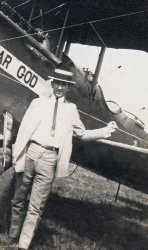
- Living Barbie: 1959
- ... sure. Another theory is that she made it for the trip to Cincinnati that RCA sent my father on. That week-or-two trip included wives. In ... Posted by aenthal - 11/24/2017 - 7:17pm -
